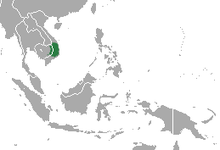
The Zanzibar red colobus is a species of red colobus monkey endemic to Unguja, the main island of the Zanzibar Archipelago, off the coast of Tanzania. It is also known as Kirk's red colobus after Sir John Kirk, the British Resident of Zanzibar who first brought it to the attention of zoological science. It is now classified as an endangered species and in the mid-1990s was adopted as the flagship species for conservation in Zanzibar. The population is still decreasing, and conservationists are attempting to work with the local government to devise a proper, effective strategy to protect the population and habitat. Challenges include the species' habitat, which is limited to the archipelago. The species has been reclassified three times; it was previously in the genus Colobus, then in the genus Procolobus, and later in the genus Piliocolobus.

The red-shanked douc is an arboreal and diurnal Old World monkey belonging to the Colobinae subfamily. They are endemic to Laos, Vietnam, and Cambodia. They are known for their bright colors and exhibit sexual dimorphism through their body size. The species has been declared critically endangered by the International Union for Conservation of Nature, with the main threats being: hunting, habitat loss and pet trade. They are one of three species in the genus Pygathrix, the other two being the black-shanked and gray-shanked doucs.

The doucs or douc langurs make up the genus Pygathrix. They are colobine Old World monkeys, native to Southeast Asia, which consists of these 3 species: red-shanked douc, black-shanked douc, and gray-shanked douc.

Snub-nosed monkeys are a group of Old World monkeys and make up the entirety of the genus Rhinopithecus. The genus is rare and not fully researched. Some taxonomists group snub-nosed monkeys together with the genus Pygathrix.

The pig-tailed langur, monotypic in genus Simias, is a large Old World monkey, endemic to several small islands off the coast of Sumatra in Indonesia. Its face is black, its fur is black-brown and it has a relatively short tail. It is a diurnal species, feeding in the rainforest canopy on leaves, and to a lesser extent, fruit and berries. Little is known of its natural history, but it is heavily hunted, its populations have been declining rapidly and the International Union for Conservation of Nature has assessed its conservation status as being "critically endangered". It has been included on a list of the World's 25 Most Endangered Primates.

The black bearded saki is a species of New World monkey, native to the Amazon rainforest of South America, specifically to an area of north-eastern Brazil. It is one of five species of bearded saki. Bearded sakis are medium-sized (50 cm), mostly frugivorous primates, specialised in seed predation. The genus name Chiropotes means "hand-drinker" as they have been observed using their hands as ladles for scooping water into their mouths. This behavior is thought to be a way of maintaining and protecting their characteristic beards. The black bearded saki's habitat has undergone heavy habitat fragmentation, making the future conservation status of the species uncertain.

The western gorilla is a great ape found in Africa, one of two species of the hominid genus Gorilla. Large and robust with males weighing around 168 kilograms (370 lb), the species is found in a region of midwest Africa, geographically isolated from the eastern gorilla. The hair of the western species is significantly lighter in color.

The pygmy slow loris is a species of slow loris found east of the Mekong River in Vietnam, Laos, eastern Cambodia, and China. It occurs in a variety of forest habitats, including tropical dry forests, semi-evergreen, and evergreen forests. It was originally classified within Nycticebus until it was transferred to the genus Xanthonycticebus in 2022. Two species are recognised, the northern pygmy loris X. intermedius from northern Vietnam, Laos and China and the southern pygmy loris X. pygmaeus from southern Vietnam, Laos and Cambodia. The animal is nocturnal and arboreal, crawling along branches using slow movements in search of prey. Unlike other primates, it does not leap. It lives together in small groups usually with one or two offspring. An adult can grow to around 19 to 23 cm long and has a very short tail. It weighs about 450 g (1.0 lb). Its diet consists of fruits, insects, small fauna, tree sap, and floral nectar. The animal has a toxic bite, which it gets by licking a toxic secretion from glands on the inside of its elbows. The teeth in its lower jaw form a comb-like structure called a toothcomb that is used for scraping resin from tree bark.

The golden-crowned sifaka or Tattersall's sifaka is a medium-sized lemur characterized by mostly white fur, prominent furry ears, and a golden-orange crown. It is one of the smallest sifakas, weighing around 3.5 kg (7.7 lb) and measuring approximately 90 cm (35 in) from head to tail. Like all sifakas, it is a vertical clinger and leaper, and its diet includes mostly seeds and leaves. The golden-crowned sifaka is named after its discoverer, Ian Tattersall, who first spotted the species in 1974. However, it was not formally described until 1988, after a research team led by Elwyn L. Simons observed and captured some specimens for captive breeding. The golden-crowned sifaka most closely resembles the western forest sifakas of the P. verreauxi group, yet its karyotype suggests a closer relationship with the P. diadema group of eastern forest sifakas. Despite the similarities with both groups, more recent studies of its karyotype support its classification as a distinct species.

The grey-shanked douc langur is a douc species native to the Vietnamese provinces of Quảng Nam, Quảng Ngãi, Bình Định, Kon Tum, and Gia Lai. The total population was estimated at 550 to 700 individuals in 2004. In 2016, Dr. Benjamin Rawson, Country Director of Fauna & Flora International's Vietnam Programme, announced a discovery of an additional population including more than 500 individuals found in Central Vietnam, bringing the total population up to approximately 1000 individuals.
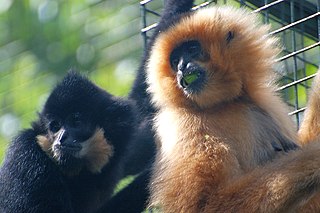
The yellow-cheeked gibbon, also called the golden-cheeked gibbon, the yellow-cheeked crested gibbon, the golden-cheeked crested gibbon, the red-cheeked gibbon, or the buffed-cheeked gibbon, is a species of gibbon native to Vietnam, Laos, and Cambodia. The species was discovered and named after the British naturalist Gabrielle Maud Vassal.
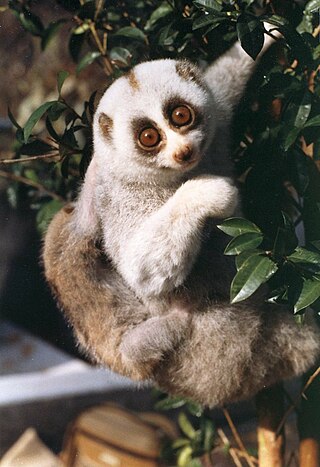
The Bengal slow loris or northern slow loris is a strepsirrhine primate and a species of slow loris native to the Indian subcontinent and Indochina. Its geographic range is larger than that of any other slow loris species. Considered a subspecies of the Sunda slow loris (N. coucang) until 2001, phylogenetic analysis suggests that the Bengal slow loris is most closely related to the Sunda slow loris. However, some individuals in both species have mitochondrial DNA sequences that resemble those of the other species, due to introgressive hybridization. It is the largest species of slow loris, measuring 26 to 38 cm from head to tail and weighing between 1 and 2.1 kg. Like other slow lorises, it has a wet nose (rhinarium), a round head, flat face, large eyes, small ears, a vestigial tail, and dense, woolly fur. The toxin it secretes from its brachial gland differs chemically from that of other slow loris species and may be used to communicate information about sex, age, health, and social status.

The wildlife of Cambodia is very diverse with at least 162 mammal species, 600 bird species, 176 reptile species, 900 freshwater fish species, 670 invertebrate species, and more than 3000 plant species. A single protected area, Keo Seima Wildlife Sanctuary, is known to support more than 950 total species, including 75 species that are listed as globally threatened on the IUCN Red List. An unknown amount of species remains to be described by science, especially the insect group of butterflies and moths, collectively known as lepidopterans.
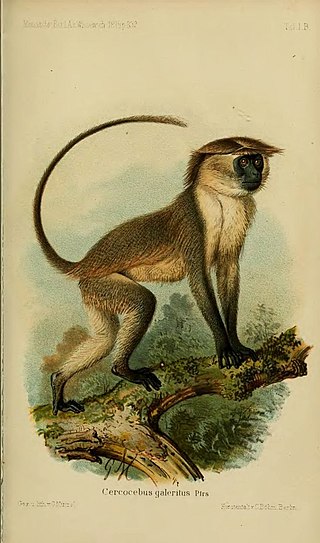
The Tana River mangabey is a highly endangered species of primate in the family Cercopithecidae. Some authorities have included the taxa agilis and sanjei as subspecies of this species, while others award these full species status.

The gray snub-nosed monkey, also known as Brelich's snub-nosed monkey, Guizhou snub-nosed monkey, and Guizhou golden monkey, is a species of primate in the family Cercopithecidae. It is endemic to China, where it is known as the Guizhou golden hair monkey (黔金丝猴) or gray golden hair monkey (灰金丝猴). It is threatened by habitat loss. Of the three species of snub-nosed monkeys in China, the gray snub-nosed monkey is the most threatened, with a total population thought to number fewer than 400 individuals.

Germain's langur is an Old World monkey native to Thailand, Myanmar, Cambodia, Laos and Vietnam. The monkey was previously included in Trachypithecus cristatus and Trachypithecus villosus.

The Tonkin snub-nosed monkey or Dollman's snub-nosed monkey is a slender-bodied arboreal Old World monkey, endemic to northern Vietnam. It has black and white fur, a pink nose and lips, and blue patches around the eyes. It is found at elevations from 200 to 1,200 m on fragmentary patches of forest on craggy limestone areas. First described in 1912, the monkey was rediscovered in 1989 but is exceedingly rare. Out of the five snub-nosed monkey species in the world, the Tonkin snub-nosed monkey is the rarest. In 2008, fewer than 250 individuals were thought to exist, and the species was the subject of intense conservation effort. The main threats faced by these monkeys are habitat loss and hunting, and the International Union for Conservation of Nature has rated the species as "critically endangered".

Phước Bình National Park is a national park in the commune of Phước Bình, Bác Ái District, Ninh Thuận Province. It is located 62 km north-west from Phan Rang town, the capital of Ninh Thuận Province, on the border with Lâm Đồng and Khánh Hòa provinces. Phước Bình National Park was classified as a nature reserve by Decision 125/2002/QD dated 26 September 2002. On 8 June 2006 it was established as a national park under Decision number 822/QĐ-TTg dated 8 June 2006 by then Vice Prime Minister of Vietnam Nguyễn Tấn Dũng.
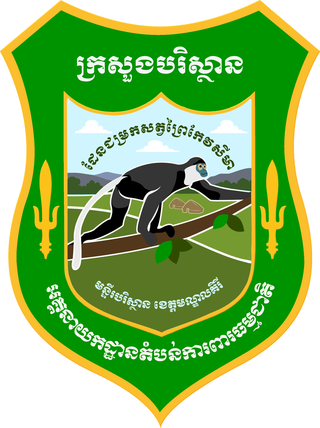
Keo Seima Wildlife Sanctuary is a 2,926.9 km2 (1,130.1 sq mi) protected area of mixed seasonal tropical forest in eastern Cambodia, located in Mondulkiri and Kratié provinces. The area was first established as Seima Biodiversity Conservation Area in 2002, later becoming Seima Protection Forest in 2009, finally becoming Keo Seima Wildlife Sanctuary in 2016. The site is of national, regional, and global importance for a range of biodiversity, with more than 950 species recorded within the protected area. It is also the ancestral and contemporary home of a large number of the Bunong ethnic group.

